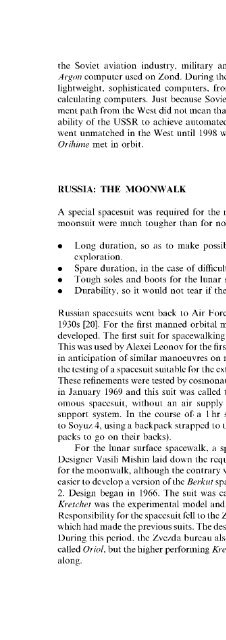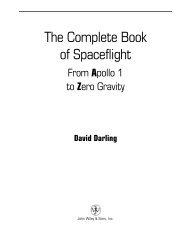- Page 2:
Soviet and Russian Lunar Exploratio
- Page 6:
Brian Harvey 2 Rathdown Crescent Te
- Page 10:
3 Planning the lunar landing 45 Vos
- Page 14:
8 Return to the moon 287 After N-l:
- Page 18:
Prologue Siberia, summer of 1976. N
- Page 22:
Although the United States Apollo p
- Page 26:
The 8K78 71 The Ye-6 lander 73 Dish
- Page 30:
Lunokhod returns to landing stage 2
- Page 34:
Abbreviations and acronyms AIS Auto
- Page 38:
1 Origins of the Soviet lunar progr
- Page 42:
Sergei Korolev, Mstislav Keldysh Wi
- Page 46:
Introducing the father of the Sovie
- Page 50:
On rocket research into the upper l
- Page 54:
pad for the returning spacecraft. H
- Page 58:
The R-7 called a 'packet' design -
- Page 62:
• An academy of sciences, to prov
- Page 66:
Sputnik
- Page 70:
spacecraft be sent to the moon. One
- Page 74:
They were hypergolic and fired on c
- Page 78:
Early tracking dish, Crimea ONLY HO
- Page 82:
and carefully sifted for clues. Wha
- Page 86:
First Cosmic Ship arose from a 1956
- Page 90:
First Cosmic Ship, top stage Gringa
- Page 94:
In Britain, the director of the lar
- Page 98:
gammas, where a response was consid
- Page 102:
Sergei Vernov But 8,000 km out from
- Page 106:
in Leningrad in 1955. The first tra
- Page 110:
The station swung around the south
- Page 114:
Automatic Interplanetary Station ar
- Page 118:
Instruments of the Automatic Interp
- Page 122:
3 Planning the lunar landing After
- Page 126:
shaped acorn-like cabin. Tikhonravo
- Page 130:
9 S 7 6 5 Soyuz complex - second bl
- Page 134:
aspect of the plan. Alexander Sharg
- Page 138:
Joint flight to the moon proposed b
- Page 142:
were disputed by some Soviet scient
- Page 146:
of a government diktat from on high
- Page 150:
delayed, had a difficult design his
- Page 154:
the moon. The 50 tonnes were gradua
- Page 158:
have a thrust of 5,760 tonnes, able
- Page 162:
tried to mediate between Sergei Kor
- Page 166:
Key government and party decisions
- Page 170:
Ye-1 to -4 series, which was provin
- Page 174:
The new 8K78 rocket, including bloc
- Page 178:
Landing cabin Height 112 cm Base 58
- Page 182:
Dishes at Yevpatoria
- Page 186:
Once again, the block L let everyon
- Page 190:
Georgi Babakin health. He returned
- Page 194:
Luna mid-course correction Luna 6 o
- Page 198:
Zond 3 over Mare Orientale lines. T
- Page 202:
Zond 3: scientific instruments Two
- Page 206:
Cosmonaut Alexei Leonov described h
- Page 210:
Luna 9 camera system They were not.
- Page 214:
In minutes, the world had seen the
- Page 218:
Luna 13 images meter which found th
- Page 222:
Ye-6, -6M: scientific outcomes Luna
- Page 226:
design bureau in Dnepropetrovsk. It
- Page 230:
Luna 10 cabin The discoveries of Lu
- Page 234:
Luna 11, 12 design presumably this
- Page 238:
MiKCVTO? Ye-6LF (originally Ye-7) H
- Page 242:
Luna 10 and mother ship Summary of
- Page 246:
Ye-6S, Ye-6LF, Ye-6LS series: scien
- Page 250:
5 The first cosmonauts to the moon
- Page 254:
RD-253 with zirconium. OKB-456 deve
- Page 258:
Russia's UR-500K Proton Length 44.3
- Page 262:
The slogan of the GIRD group, writt
- Page 266:
Two months later, on 24th September
- Page 270:
Spurring people on - Korolev in 196
- Page 274: Americans took a different view). K
- Page 280: Engines Thrust (each) Total thrust
- Page 284: to launch a very big space station.
- Page 288: The Soyuz spacecraft The initial te
- Page 292: Soyuz spacecraft rendezvous, dockin
- Page 296: From August 1964, the Soviet lunar
- Page 300: The Soviet around-the-moon mission
- Page 304: Cosmos 146 was the fifth flight of
- Page 308: Rendezvous in Earth orbit
- Page 312: housed here, and it was from this m
- Page 316: • One 11D411 RD-858 main engine w
- Page 320: LK ladder
- Page 324: The return-to-Earth profile was qui
- Page 330: Orlan, descendant of the Kretchet
- Page 334: The operations on the moon would co
- Page 338: Although no cosmonaut ever did make
- Page 342: Chief designer Valentin Glushko wit
- Page 346: This group was selected for the fli
- Page 350: Sergei Korolev with Konstantin Feok
- Page 354: Russia's moon team: selection for a
- Page 358: First group of six: Yuri Gagarin, V
- Page 362: The moon teams: Moon Team 2: Valeri
- Page 366: COSMONAUTS SELECTED TO LAND THE LK
- Page 370: went into the deserts of Somalia so
- Page 374: Alexei Leonov landed in a forest in
- Page 378:
Oleg Makarov Americans described hi
- Page 382:
Nikolai Rukhavishnikov planned expe
- Page 386:
\ ^ i . Vitally Sevastianov RETURNI
- Page 390:
completely undermined anyway at the
- Page 394:
6 Around the moon The moon race bet
- Page 398:
Zond 5
- Page 402:
Zond 5 in the Indian Ocean Zond 5's
- Page 406:
Zond 6 around the moon Even as the
- Page 410:
Zond over Crater Tsiolkovsky times,
- Page 414:
Remarkably, Zond 6 images survived
- Page 418:
Earthrise for Zond 7 their porthole
- Page 422:
moon programme. Although this was n
- Page 426:
Lunokhod on top of Proton SOYUZ 4-5
- Page 430:
Yevgeni Khrunov, Alexei Yeliseyev d
- Page 434:
Boris Volynov Back in space, Volyno
- Page 438:
N-l ON THE PAD By the time of these
- Page 442:
preparations to send two probes to
- Page 446:
from one brilliant achievement to a
- Page 450:
touchdown, the 90 cm long drill arm
- Page 454:
(the one achieved after major orbit
- Page 458:
Following the first moon landing, t
- Page 462:
of the Earth's full globe over the
- Page 466:
L-1/Zond series: scientific outcome
- Page 470:
initiation down to 1,500 m over the
- Page 474:
match the three days of two Apollo
- Page 478:
Test Peroxide (HTP). Only one other
- Page 482:
21 Feb 1969 3 Jul 1969 27 Jun 1971
- Page 486:
Valentin Glushko, now chief designe
- Page 490:
Salyut - an alternative programme p
- Page 494:
• Successfully tested out its lun
- Page 498:
decided, in 1968, to send an Apollo
- Page 502:
[7] Gracieux, Serge: Le joker Sovie
- Page 506:
KT descent stage Engine One 11D417
- Page 510:
750 kg to 1,920 kg. At highest thru
- Page 514:
Luna 16 stage left on the moon The
- Page 518:
Luna 16 moonrock For NASA and Weste
- Page 522:
Transmash designed tanks for the Re
- Page 526:
To guide the route chosen, Lunokhod
- Page 530:
Lunokhod Weight Diameter Height Whe
- Page 534:
Lunokhod tracks across the moon in
- Page 538:
Lunokhod route-planning conference
- Page 542:
stop to take panoramic pictures. Fo
- Page 546:
End of Lunokhod journey October 197
- Page 550:
ten-hour shifts, 14 lunar days at a
- Page 554:
The drilling operation took 40 min
- Page 558:
Lunokhod 2 Luna 21 entered a near-c
- Page 562:
Lunokhod 2 wheel marks on the moon
- Page 566:
The journey of Lunokhod 2 lunar sur
- Page 570:
that there was a very weak permanen
- Page 574:
It was a full year before the next
- Page 578:
of designers of 1946. He was the co
- Page 582:
Luna 24 returning to the Earth Ye-8
- Page 586:
• Telescopes on the lunar farside
- Page 590:
Valeri Barsukov Despite the heat of
- Page 594:
ACHIEVEMENTS OF THE SOVIET AUTOMATI
- Page 598:
[11] Surkov, Yuri: Exploration of t
- Page 602:
of no fewer than 450 sec. A lunar e
- Page 606:
cosmonaut at a time. As was the cas
- Page 610:
none progressed beyond the aspirati
- Page 614:
engineering and scientific sense, a
- Page 618:
[8] Rebrov, Colonel M.: But this is
- Page 622:
298 List of all Soviet moon probes
- Page 626:
300 List of all Soviet moon probes
- Page 630:
(1988-2003); Gordon Hooper (1990),
- Page 634:
Gorin, Peter A.: Rising from the cr
- Page 638:
Pesavento, Peter: Soviet space prog
- Page 642:
Wright, Pearce: Vasili Mishin - spa
- Page 646:
Bogomolov, Alexei 221 Boguslavsky,
- Page 650:
Kennedy, John F. Moon speech, 52 Pr
- Page 654:
Printing: Mercedes-Druck, Berlin Bi
- Page 658:
Tikhonravov, Mikhail (cont.) Propos







